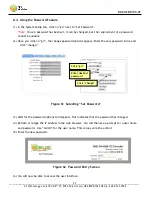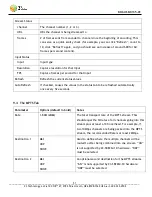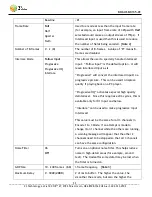
DOC-USR-0135-01
___________________________________________________________________________________________
Z3 Technology, LLC
♦
100 N 8
th
ST, STE 250
♦
Lincoln, NE 68508-1369 USA
♦
+1.402.323.0702
62
Dest Address
192.168.x.y
(192.168.0.6)
The IP address that the encoder is streaming to.
Dest Port
0 – 9999 (
5004
)
The port that the encoder is streaming to.
Aux TS File Enable
(UDP Only)
True
False
For UDP streaming only. If UDP is being streamed,
this allows the same UDP stream to be saved to a TS
file. The name of the file is specified in “Aux TS
File Location.”
Aux TS File Location
(UDP Only)
/tmp/aux1.ts
Appears if “Aux TS File Enable” is set to “True.”
Specifies where to save the TS file. For example, if
a USB drive is connected, the value
“/media/sda1/example.ts” could be specified.
Video PID (UDP Only)
0 – 8191 (
220
)
PID assigned to video in the TS stream.
PCR PID (UDP Only)
0 – 8191 (
520
)
PID assigned to PCR in the TS stream.
PMT PID (UDP Only)
0 – 8191 (
31
)
PID assigned to PMT in the TS stream.
TS Rate (UDP Only)
125K – 20000K (
8000K
)
The rate of the transport stream. Normally, this
value should be set to 1.25 * (video b audio
bitrate). This can be set to higher values to allow
leeway for times when many bits are needed to
encode. This can be especially useful for ensuring
smooth playback at lower bitrates (see Section
6.10, “Adjusting the UDP TS Rate,” on page 28).
TS Lowlat Mode (UDP
Only)
True
False
Turning “Lowlat Mode” on causes the TS muxer to
instead send packets out as soon as it receives them
rather than buffering them. This results in lower
latency at the expense of decreased network
efficiency and a less smooth bitstream. There is a
limit of 5Mbps for TS Lowlat Mode.
Authentication
(RTMP only)
Disable
Enable
Supports entering an authentication User name and
Password for RTMP. When enabled, a “User” and
“Password” text box appear. The user then enters
the appropriate User name and Password.
User (RTMP Only)
User name to enter when “Authentication”
enabled.
Password (RTMP Only)
Password to enter when “Authentication” is
enabled.




















